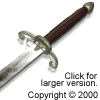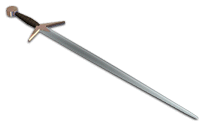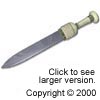
| Part One: Swords and Daggers of the Heraldic Age (Editor's Note: This is the first of a three part series on weapons of the heraldic age, their construction and basic use. Part one deals with the various swords and daggers carried by the common soldier during this time period.)
The Sword was the classic weapon for almost three millennia. In its earliest design, the "Queen of Battle" was crude but effective. The original broadleaf shaped weapons made of bronze were efficient but lacked the strength for anything other than as a real slicing or stabbing weapon. Classic sword fighting as presented in Hollywood movies simply did not exist because bronze weapons would bend or break during any sort of heavy use. Any soldier who used his weapon to parry an opponent attack found himself without one and died in battle.
With the advent of the Iron Age, the sword was greatly improved although the iron would still bend and the blade edge could not stand any serious blow. But it was the material strength of iron and later steel that created the sword as the weapon we know today.
A sword could be identified by the culture in which it was used. The 'Roman short sword' is an excellent example of this, as weapons frequently dictated the fighting style or vice-versa. The Romans developed this fighting style to the point that they defeated most of the ancient world with it. Ironically, the Romans got much of their style of fighting and weapons from the Celts.
As with any effective weapon of battle, the sword went through stages of strength and power that affects all weapons worthy of a defense. In the golden age of the sword, it had evolved into the classic weapon we know today. It was highly efficient and deadly, as one could kill with the point, either of two edges, and with the pommel if properly trained. The sword also came to possess strong symbolic meanings, different virtues being assigned to the edges. The quillion or crosspiece formed across the handle of the sword resembled a Christian cross, furthering the symbolism and allowing the user to catch an opponent's blade.
As armor improved, so did the size and effectiveness of the sword. This continued until the weight of armor worn by the defender was great enough that a new tactic was developed. The full suit of armor had become so restrictive that a man wearing it could not move quickly, and a man without such a suit, but with a light weapon, could easily outmaneuver and defeat his enemy. In combination with the advent of the gun, the cycle of weapon and defense went full circle, and with the death of the suit of armor, the modern rapier (or foil) was born.
It is difficult to discuss the sword in great detail, as each civilization developed its own variations of the weapon in response to its culture and use. There was also constant argument among the users themselves as whether the point or the edge was the more efficient weapon. Therefore, we will only discuss the main weapons or variants in use during the middle ages.
Baselard: A knife or short sword bearing a hilt or guard in the shape of the letter I, the guard allowed the user to catch an opponent's blade. It quickly became the weapon of choice for many foot soldiers and was used in conjunction with a rapier during the 17th and 18th Centuries.
Bastardsword: Also known as the hand and a half sword or Longsword. This sword was popular during the 1400's, and they were generally four feet in length. The main feature was a longer handle that allowed the blade to be used in two hands, although it was short and light enough to use one handed when desired or necessary.
Broadsword: The Broadsword was the general blade in use from the sixth century on. It was usually from two-and-a-half to three-and-a-half feet long with two edges and a one handed handle. It was light enough to swing all day and heavy enough to impart a severe blow from its edge, which was surprisingly rarely sharpened. The thickness of the edge, between 1/8 and 1/16 of an inch was thin enough to concentrate the blow and do serious damage to the opponent.
Cutlass: A much heavier version of the saber. While its weight made it impossible to use in the manner of the Saber, the cutlass had an advantage in that its weight and shape made it readily usable by the novice with deadly efficiency against untrained opponents. Sailors and pirates mainly used the weapon.
Dagger: A short pointed knife with no guard. There were many forms of daggers worn during the Middle Ages. Knights and squires at court wore daggers almost all the time in deference to the sword.
Epee: French for Sword.
Falchion: A short, heavy, broad-bladed sword with a single edge, bearing a similarity to a heavy scimitar, also an archaic term for any sword. Sometimes a converted sickle was called a Falchion.
Rapier: The rapier is strange as a sword weapon, as it sometimes had no edge at all, just a skinny supporting piece of steel and a point. The main advantage of this weapon is its speed of use, as the weapon has a very light blade. The rapier much resembles the modern fencing weapons of today although it is a little thicker. With proper training the weight of this weapon allowed its user to fight almost without breaking a sweat.
Saber or Scimitar: A medium length single edged sword that was frequently used by officers and Calvary in the military. Its curved shape made it easy to cut with but more difficult to use effectively unless the user had proper training. Its shape and weight could be an advantage in battle, as the curve allowed the user to catch and pull away an opponent's blade. The scimitar was an oriental version of the saber with a slightly more drastic curve to the blade.
BW, January, 2000
Back to Weapons of the Heraldic Age Main Page
Part One: Swords and Daggers
Part Two: Siege and Missile Weapons
Part Three: Other Hand Weapons and Polearms
Links:
|
Thursday, December 26th, 2019
Attention visitors: Tartans.com is back. Please note that this is a snapshot of the site as it existed nearly 20 years ago and you may encounter broken links; we are still combing through the site and correcting those as we find them. Please also note that some sections are currently not functional, primarily the discussion forums/clan chat boards.
|
** HOME - First Time Visitors - Glossary - - Contact Us ** Awards | Bibliography | Clan Calendar | Clan Chat | Clan Finder | History | Famous Scots | Genealogy | Great Hall of the Clans | Links | News and Features | Scots on the Net | Search | Site Map The Gathering of the Clans
Copyright 1995- Tartans.com - All Rights Reserved. |

 Claymore, Two-handed sword and Greatsword: The large two-handed swords were popular in Scotland during the 15th, 16th and the 17th centuries. Ranging in length from just over four feet to six feet, they possessed handles that were 18" - 21" in length. Overall the swords weighed much less than people think, most only six or seven pounds, although there are examples that weigh as much as ten pounds. The term Claymore was also used to describe a Scottish broadsword with a basket hilt.
Claymore, Two-handed sword and Greatsword: The large two-handed swords were popular in Scotland during the 15th, 16th and the 17th centuries. Ranging in length from just over four feet to six feet, they possessed handles that were 18" - 21" in length. Overall the swords weighed much less than people think, most only six or seven pounds, although there are examples that weigh as much as ten pounds. The term Claymore was also used to describe a Scottish broadsword with a basket hilt.